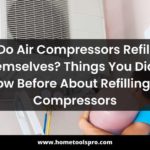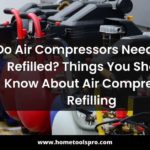As a DIY enthusiast, I often feel like a captain steering my ship through the choppy waters of home improvement tasks. It’s exhilarating to take on new projects and see them through to completion, but when something goes wrong, it can be disheartening.
Recently, I found myself in the midst of an air compressor conundrum: why was my trusty machine not building pressure?
It’s easy to feel frustrated when your tools don’t work as they should. Our air compressors are like loyal companions that help us tackle all sorts of jobs around the house or garage. When they fail us, it’s natural to wonder what we did wrong.
However, there are many reasons why an air compressor might not build pressure, and with some troubleshooting techniques and a bit of know-how, you can get back on track in no time. So let’s dive into some common causes for low pressure and how to fix them!
Check for Leaks in the System
Before moving on, it’s important to check for any sneaky leaks lurking in your system. Even the smallest leak can prevent your air compressor from building pressure.
To start, turn off your compressor and remove all the attachments connected to it. Then, inspect each component of the system for damage or wear that may be causing a leak.
Begin by checking the hoses first. Look for any cracks or holes along the length of each hose, including where they connect to different components of the system. Tighten any loose fittings and replace damaged hoses as necessary.
Next, examine all valves and connections thoroughly for leaks. Don’t forget about checking the tank itself! Inspect it closely for any signs of rust or corrosion that could cause a leak in your system. If you find any damage, replace or repair them immediately before attempting to use your air compressor again.
Once you’ve checked everything over and made sure there are no leaks present, move onto examining the compressor’s motor or pump section next.
By taking these measures to detect possible leaks within your air compressor system first, you’ll increase its efficiency while also prolonging its lifespan overall!
Examine the Compressor’s Motor or Pump
I’ll now discuss examining the compressor’s motor or pump.
Before doing so, it’s important to check for loose or damaged parts that may be causing issues with the system. This could include anything from a broken belt to a cracked piston ring.
Additionally, listening for unusual noises such as clanking or grinding can give insight into potential problems with the motor or pump.
By checking for these issues and addressing them promptly, you can help ensure your air compressor operates smoothly and efficiently.
Check for Loose or Damaged Parts
Make sure all parts are secure and intact to ensure smooth operation of your machine. Loose or damaged parts can cause your air compressor to not build pressure.
Check the bolts, nuts, and screws that hold your compressor together to make sure they’re tight. Make sure that no hoses or pipes are cracked or broken. If you find any loose or damaged parts, tighten them up or replace them immediately.
A common problem with air compressors is a rattling noise coming from the motor or pump. This could be caused by a loose part inside the machine. If you hear an unusual noise coming from your air compressor, turn it off immediately and check for any loose parts that may be causing the noise.
Listen for Unusual Noises
You may hear unusual noises coming from your machine, which could indicate a potential issue that needs to be addressed for optimal performance. These noises could be caused by a variety of factors, such as loose belts or bearings, worn-out piston rings, or damaged valves. If you ignore these sounds and continue using your air compressor, it could lead to more serious problems down the line.
One way to isolate the source of the noise is to listen carefully when the machine is in operation. Try to identify where the sound is coming from and what kind of noise it’s making (e.g., grinding, hissing, squeaking). Once you have identified the problem area, you can either fix it yourself if you’re experienced with air compressors or take it to a professional for repairs.
Remember that addressing any unusual noises early on can help prevent further damage and prolong the life of your air compressor.
As you troubleshoot your air compressor’s lack of pressure, another step you can take is to clean or replace the air filter.
Clean or Replace the Air Filter
Cleaning or replacing the air filter can enhance the efficiency of the compressor’s airflow and increase its ability to generate pressure. A clogged air filter is one of the most common reasons for an air compressor not building up pressure.
When dust, debris, and other particles accumulate in the air filter over time, they obstruct the flow of air into the compressor pump. As a result, this reduces the amount of power that reaches the pump and hampers its ability to produce compressed air.
To clean or replace your air filter, first turn off your compressor and disconnect it from any power source. Locate where your air filter is located and remove it carefully from its housing.
If cleaning is all that’s needed, use a soft brush to remove dirt and debris from both sides of your filter. If your filter has become too damaged or worn out due to excessive use, you’ll need to replace it with a new one.
By cleaning or replacing your air filter regularly, you will allow for better airflow into your compressors’ system resulting in an improved performance overall. However, if this doesn’t solve your issue with low-pressure output still persists after doing so, there could be another problem at hand such as a faulty pressure switch adjustment, which we will cover next!
Adjust the Pressure Switch
I hope you’ve taken my advice and checked your air filter! But if that didn’t solve the problem, it’s time to move on to adjusting the pressure switch.
The pressure switch is responsible for turning your compressor on and off when it reaches a certain pressure level. If it’s not set correctly, your compressor won’t build up enough pressure.
To adjust the pressure switch, first locate it. It should be near the motor and have two wires attached to it. Use a wrench or pliers to loosen the lock nut that holds the adjustment screw in place. Then, turn the screw clockwise to increase the cut-out pressure (the point at which your compressor turns off) or counterclockwise to decrease it. Be sure to consult your owner’s manual for specific instructions as different models may require different adjustments.
If adjusting the pressure switch doesn’t work, there could be other issues such as a leak in the system or a malfunctioning valve. These problems will likely require a professional repair, but don’t give up hope just yet! Adjusting the pressure switch is often an easy fix that can save you time and money.
Now that we’ve gone over how to adjust the pressure switch, let’s move on to draining your tank – another important step in troubleshooting why your compressor isn’t building up enough pressure.
Drain the Tank
So, one of the most important things to do for maintaining your air compressor is to drain the tank regularly. By doing this, we can remove excess moisture from the tank that can cause rust and corrosion over time.
It’s also crucial to clean the tank regularly to prevent any build-up or debris that could lead to clogs or damage. Trust me, taking these simple steps will help extend the life of your compressor and ensure it continues to work effectively for years to come.
Remove Excess Moisture
To prevent your compressor from losing efficiency, make sure to regularly drain the excess moisture that accumulates in the tank. Excess moisture can cause rust and corrosion inside the tank, which can lead to leaks and ultimately decrease the lifespan of your compressor. Moisture buildup can also affect the quality of compressed air produced by your machine, leading to poor performance or even damage to tools and equipment.
One way to remove excess moisture is to use a drain valve located at the bottom of your compressor’s tank. Simply open the valve and let any accumulated water drain out until you see no more water coming out. It’s important to do this after every use or at least once a week if you’re using your compressor frequently.
Additionally, using an air dryer or a filter with a built-in moisture trap can help remove any remaining moisture in the compressed air before it reaches your tools.
By regularly draining excess moisture from your compressor’s tank, you can ensure optimal performance and extend its lifespan.
To further maintain your compressor’s efficiency, it’s important to clean the tank regularly by removing any debris or dust that may have accumulated inside. This will not only improve airflow but also prevent clogs that could lead to pressure loss in the system.
Clean the Tank Regularly
Regularly cleaning the tank of your compressor can improve airflow and prevent clogs, ultimately leading to better performance and longer lifespan for your machine. When you use an air compressor regularly, it’s only natural that debris and dust will accumulate inside the tank over time.
This buildup can be detrimental to your compressor’s overall functionality as it restricts airflow, making it harder for the machine to compress air. To avoid this problem, make sure to clean out the tank regularly by draining any excess water or oil that may have accumulated inside. A good rule of thumb is to do this after every use or at least once a week if you’re using your compressor frequently.
Cleaning the tank is a simple process that involves opening up the drain valve located at the bottom of the tank and allowing any moisture or debris to flow out into a separate container. Once emptied, wipe down the interior with a clean cloth or sponge and let dry completely before closing up again.
By doing this regularly, you’ll not only keep your compressor running smoothly but also extend its life expectancy significantly. And speaking of maintenance, another crucial step in taking care of your air compressor is ensuring that you’re using the correct oil – something we’ll delve into next.
Using the correct oil in your air compressor is essential for maintaining optimal performance levels. It lubricates moving parts within the machine and prevents wear and tear from occurring too quickly. But with so many different types of oils available on today’s market, how do you know which one is right for your specific model? Stay tuned!
Use the Correct Oil
When it comes to maintaining your air compressor, using the correct oil is crucial. I always refer to the owner’s manual for recommendations to ensure I’m using the right type of oil for my specific compressor. Additionally, changing the oil regularly is important. This will keep my compressor running smoothly and prevent any potential damage. By following these simple steps, I can extend the lifespan of my air compressor and avoid costly repairs in the future.
Check the Owner’s Manual for Recommendations
It’s worth taking a look at the owner’s manual to see what recommendations are provided when it comes to choosing the right oil for your air compressor. The manual will usually provide specific details about which type of oil is recommended and how often it should be changed. Some compressors require synthetic oil, while others may work better with mineral-based oils. Using the wrong type of oil can cause damage to the compressor and prevent it from building up pressure properly.
In addition to providing information about the type of oil you should use, the owner’s manual may also offer tips on how to maintain your compressor in other ways. For example, it may suggest cleaning or replacing certain parts regularly to ensure that they are working properly.
By following these recommendations, you can help keep your compressor running smoothly and prevent issues like low pressure from occurring. Remember, changing the oil regularly is just one part of maintaining your air compressor – be sure to follow all recommended maintenance procedures for best results!
Change the Oil Regularly
Keep your compressor running smoothly by giving it an oil change every so often. Just like with a car, the oil in your air compressor can become dirty and lose its effectiveness over time. This can cause the compressor to not build pressure as well as it should.
Regularly changing the oil will help keep your compressor running at peak performance and prevent any issues from arising. To change the oil in your compressor, start by consulting the owner’s manual to determine what type of oil is recommended for your machine. Then, locate the drain plug on the bottom of the tank and use a wrench to remove it.
Allow all of the old oil to drain out completely before replacing the plug and adding new, clean oil to the tank. By keeping up with regular maintenance like this, you’ll be able to avoid any major problems with your air compressor and ensure that it continues working properly for years to come. Remember, if you’ve changed the oil in your air compressor but are still experiencing issues with building pressure, don’t hesitate to seek professional assistance if needed.
There may be other underlying problems that require more specialized knowledge or tools than what you have on hand.
Seek Professional Assistance if Needed
If my air compressor isn’t building pressure after checking the oil, it might be time to seek professional assistance. I’d want to find a qualified technician with experience repairing air compressors. Once I’ve found someone, I’d ask for a quote for repairs or replacement parts. This way, I can make an informed decision about how to proceed.
Remember to always seek professional assistance if needed.
Find a Qualified Technician
You’ll want to find a skilled technician who can diagnose and fix the issue with your machine. It’s important to choose someone who has experience working with air compressors and has the necessary qualifications. Look for a technician who is certified by organizations like the National Institute for Automotive Service Excellence (ASE) or the International Ground Source Heat Pump Association (IGSHPA).
You can also check online reviews and ask for referrals from friends or colleagues. When you’ve found a qualified technician, be sure to communicate clearly about what’s happening with your machine. Give them as much information as possible about when you first noticed the problem, any strange noises or smells that you’ve observed, and any attempts at troubleshooting that you’ve made yourself.
With this information in hand, they should be able to quickly diagnose the issue and provide you with an estimate of how much repairs will cost. From there, you can decide whether it makes more sense to repair your current compressor or invest in replacement parts.
Get a Quote for Repairs or Replacement Parts
To determine the best course of action for your machine, seek a quote from a qualified technician who can provide an estimate for repairs or replacement parts.
It’s important to know what you’re dealing with before making any decisions about fixing or replacing your air compressor. A qualified technician will be able to diagnose the issue and provide an accurate estimate for the necessary repairs or replacement parts.
Getting a quote is also helpful in determining if it’s more cost-effective to repair or replace your air compressor. Sometimes, the cost of repairs can exceed the value of the machine, making replacement a better option.
By getting a quote from a professional, you’ll have all the information needed to make an informed decision that’s both financially responsible and ensures maximum longevity of your equipment.
Conclusion
Well, folks, that’s all there is to it! If you’re experiencing issues with your air compressor not building pressure, there are a few things you can check and adjust before seeking professional assistance. Remember to always prioritize safety by turning off the power and releasing any remaining pressure in the tank before examining or making adjustments.
Before I go, I want to leave you with an interesting statistic: did you know that compressed air systems account for approximately 10% of industrial electricity consumption? That’s right – according to the U.S. Department of Energy, compressed air is one of the most expensive forms of energy in manufacturing facilities.
So not only is maintaining your air compressor important for its functionality, but it can also save you money in the long run by increasing efficiency and reducing energy consumption. Keep this in mind as you troubleshoot any issues with your system.
Happy compressing!


